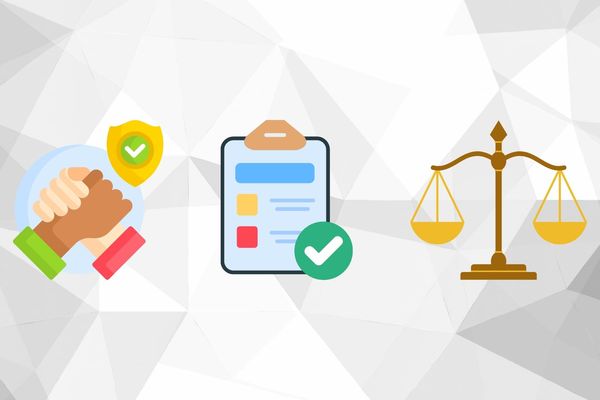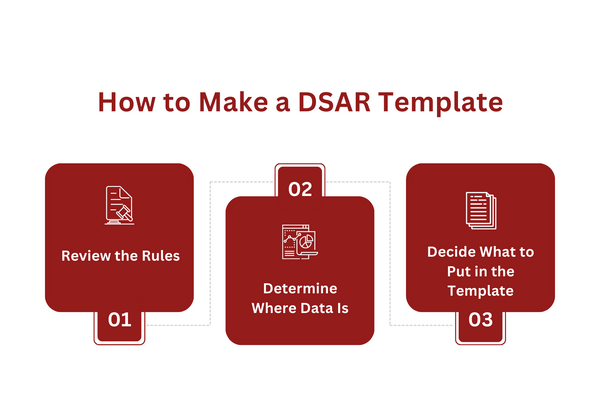
Managing requests for customers to see the personal data that businesses collect is a big deal nowadays. This article will introduce you to something that can help: the DSAR template. We’ll look at what DSARs are and why they matter to all kinds of businesses, big and small.
DSARs are when people ask to access the personal info a business has about them. It’s not just about following rules; it’s about building trust with consumers and protecting your reputation.
Handling DSARs can be super overwhelming, but don’t freak out. Our data subject access request template makes it easy to follow privacy laws like EU GDPR and CCPA.
Let’s dive right in.
Key Takeaways
Data subject access requests aren’t just about rules. They’re about developing relationships with customers who share their personal data. It helps businesses show they care.
There are different rules – like CCPA in California and GDPR in Europe. Knowing the rules is super key, especially with big fines around.
Just like hunting for treasure, businesses need to know where data is kept. It could be in-house or with outside parties.
When crafting the DSAR template, think of it like a shopping list. Decide what info customers might want, how they ask, and how to reply. Makes everyone’s life a breeze!
Why Should You Provide a DSAR Template to Consumers?
Why Should You Provide a DSAR Template to Consumers.jpg

DSARs, sometimes referred to as SAR requests, let consumers ask for their personal data from businesses. Makes sense businesses need a template for handling these requests and help keep everyone on the same page.
The DSAR software and template are good for the consumer and business. It shows the person exactly how to ask for their data. It also helps the business respond properly based on the rules while keeping the business in line and saving time instead of long back-and-forth emails or calls.
The template lets the business quickly send over the data needed. It makes it easy for the consumer to request their info without any confusion.
Using a template also builds trust. This shows consumers the business cares about protecting their data privacy. People feel more comfortable knowing the business respects their rights to control their personal information.
So templates, alongside our compliance services, help with clear communication, following regulations, saving time, and building consumer trust. Makes sense why they’re so important for businesses to handle DSARs properly!
How to Make a DSAR Template
How to Make a DSAR Template.png

Figuring out all those data privacy rules sure seems tough. But making a solid DSAR template helps big time in staying on top of things, and this little guide aims to shed some light by getting into the nitty gritty of CCPA and EU GDPR. Plus, we’ll offer up some key pointers for putting together a killer template.
Review the Rules: Understanding CCPA DSAR and GDPR
Data protection privacy rules are different depending on where you live. California has CCPA DSAR, which focuses on businesses that handle the data of Californians. It looks at stuff like how much money a business makes in a year and what they use your personal data for.
People under CCPA mainly want to know what data businesses have on them and decide if it get sold or not. If businesses don’t follow the rules or mishandle kids’ information, it can cost them big time.
The EU’s General Data Protection Regulation is different. It applies to any business that handles data on customers from the EU, no matter where they are. GDPR gives people more control over their data. They can ask to delete it or transfer it somewhere else if they want.
Businesses that mess up can get fined hard – we’re talking 4% of their total global earnings for the year or up to 20 million Euros! Sometimes, GDPR also says a business needs a Data Protection Officer to watch over how data is handled.
Determine Where Consumer Data Is
Data for a business is like something valuable you’ve stored in a big house – you need to know exactly where it is to get it quickly when you need it.
For businesses, finding consumers and other data fast matters even more. Here are some places businesses might keep data:
In-house Databases: Databases run by the business itself are like storage rooms in your own house. Things like CRM software, sales numbers, employee files – anything the business uses daily that it controls itself.
Third-party Vendors: Businesses work with outside vendors a lot – marketing agencies, cloud storage, and payment businesses – and keep data with them, too.
Decide What to Put in the Template: Crafting the Perfect DSAR
When it comes to data requests, having a game plan is key. Just like you wouldn’t go shopping without a list, putting together a template ensures you’ve got all your bases covered when those DSARs come in.
First, think about what kinds of info consumers might ask for – purchase history, account details, comments they’ve left. Make a list, just like you would for a trip to the store.
Next, be clear on how people can submit requests – email, online form, phone call. Providing those directions is like pointing people to the right aisle at the supermarket.
When you respond, be direct and to the point, and if someone asks about recent buys, share the specifics – the item’s dates, etc.
Taking time to build a solid template means a smoother ride for your team and your consumers. You’re setting everyone up for success and showing you value transparency.
Sample DSAR Template: Making Data Requests Easier
Openness and honesty are key in this digital age. People want to know how their personal data is used, and businesses build trust by letting consumers easily access that info. A good Data Subject Access Request template helps with that.
The goal is to make it simple for people to learn about how their data is handled. Crafting an easy-to-understand DSAR template shows consumers you respect their right to transparency.
[Your business’s Name] – Subject Request Form
Part 1: Personal Details
Starting with the basics is always a good strategy. Collecting accurate personal details ensures you’re accessing the right data for the right individual. This section paves the way for a seamless process down the line.
Full Name: [First Name] [Last Name]
Address: [Your Street] [City, Zip Code, Country]
Contact Number: [Your Phone Number]
Email Address: [Your Email]
Part 2: What Information Do You Want?
An essential component of any DSAR template is clarifying what data the individual wants. By listing different data categories, you’re making the process more user-friendly, allowing consumers to pinpoint their exact needs.
Example:
Please tick the boxes next to the data types you’d like to access:
Personal Details (like name, address, and date of birth)
Purchase History
Interaction History (emails, chats, calls with our team)
Marketing Preferences
Any other specific data (please specify): ___________________________
Part 3: Proof of Identity
Data security can’t be stressed enough. By asking for proof of identity, you’re ensuring the data goes only to its rightful owner. Plus, it’s a step that underscores your commitment to data safety and security.
Example:
To keep data safe, we need to make sure it’s really you! Please provide a copy of one or more of the following:
Valid Passport
Driving License
Recent Utility Bill (less than three months old)
Note: We value your security. After confirming your identity, we will safely dispose of these documents.
Part 4: Receiving Your Data
Giving consumers the choice of how they receive their data shows you care about their preferences. It’s all about making the process as smooth as possible, ensuring they feel comfortable every step of the way.
Example:
How would you like to get the data?
Paper Copy
USB Stick (securely mailed to the address above)
Note: We aim to process all requests within one month.
Part 5: Declaration
The declaration is like a seal of authenticity. It’s the consumer saying, “Yes, that’s me, and I want my data.” This section brings a personal touch, reinforcing the connection between you and the consumer.
Example:
I, [Your Full Name], confirm that the information I’ve provided is accurate. I understand that [Your Business’s Name] will use this information to find and give me the data I’ve asked for.
Signature: ________________________ Date: [DD/MM/YYYY]
Where to Send This Form?
Complete this DSAR form and send it to:
Email: [Your Business’s DSAR Email Address]
Postal Address: [Your Business’s Address]
Note: We’ll get back to you as soon as we’ve found your data! If you have questions or need help, feel free to reach out.
Closing
After really getting into this whole data subject access request template thing, we bet you’re wondering what’s next? Trying to navigate data privacy and compliance is tricky, but it’s something our team at Captain Compliance deals with every single day.
Whether you need hands-on help writing the perfect template, outsourced compliance support or just want some expert advice on bigger data protection topics, we’re ready to partner with you.
Our crew offers everything from DSAR management tools to comprehensive compliance training. We’ll help make sure your business stays on course through the constantly changing ocean of regulations.
With Captain Compliance helping steer the ship, you can throw your non-compliance worries away. So, if you’re ready to take the plunge and create a more transparent, safer future for your business and consumers, get in touch.
FAQs
Why are DSARs such a big deal?
DSARs let customers see the personal info businesses have about them. It’s not just about following rules. It’s about building trust and showing that businesses care.
Want to dive deeper? Check out our guides.
How often should a business check its DSAR template?
Businesses should peek at their DSAR templates now and then, especially when rules change. This helps keep things fresh and in line with any new guidelines.
Curious about the latest changes? Contact us to learn more.
What if a business messes up a DSAR?
Oopsies can happen! But if businesses goof up with DSARs, they might face fines. That’s why having a solid DSAR process matters a lot.
Want to know what the fines for violating the EU GDPR is? Click here.
How can DSAR software help streamline the DSAR process for businesses?
DSAR software makes handling data requests a breeze. It automates many steps, keeps things organized, and ensures businesses reply on time. Plus, with the right software, you can be sure you’re ticking all the compliance boxes.